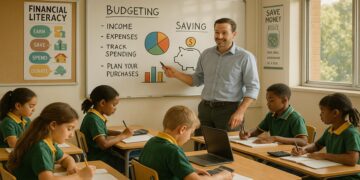Financial Education in Schools: How to Prepare Future Generations for the Financial Market

The Importance of Financial Literacy
Financial literacy is essential for navigating today’s complex world. Having a firm grasp of financial concepts allows students not only to manage their personal finances but also to navigate the broader economic landscape confidently. Students who understand fundamental concepts such as budgeting, saving, investing, and debt management are far better equipped to make informed decisions, ultimately ensuring their long-term wellbeing and security.
In Australia, a significant number of young people graduate without adequate financial knowledge, which can lead to a slew of negative consequences that may affect their future. For instance:
- Debt issues: Many young Australians mismanage credit cards and loans, leading to overwhelming debt. A recent study revealed that around 30% of young adults regularly incur credit card debt due to a lack of understanding of interest rates and repayment terms.
- Poor savings habits: Without proper financial education, young people may fail to set aside money for emergencies or future investments, risking their financial stability. The inability to save can result in a significant gap in their financial security, leaving them vulnerable during unexpected situations.
- Investment misconceptions: Without a clear understanding of the stock market, many opt for poorly thought-out investments. For example, following trends or “hot tips” without conducting proper research can lead to substantial financial losses.
It’s clear that educational institutions play a vital role in shaping financial understanding among students. By incorporating financial education into their curricula, schools can greatly enhance students’ knowledge and skills. They can:
- Empower students with knowledge about budgeting and saving, teaching them how to manage their income effectively. Providing workshops that simulate real-life budgeting scenarios can make these concepts tangible and relevant.
- Encourage critical thinking about financial decisions, helping students to evaluate the long-term implications of their choices. For instance, discussing case studies of financial mismanagement versus success can drive home the importance of making informed decisions.
- Equip future generations for a competitive financial market by teaching them about investment strategies, loan options, and the implications of financial products, thus fostering a generation of financially savvy individuals.
Incorporating these essential skills into education can help students thrive in their personal and professional lives, preparing them for the challenges they will inevitably face in the financial arena. As we explore how to implement financial education effectively, we will discuss practical steps and examples that resonate with young Australians, ensuring that they are well-prepared to embark on their financial journeys with confidence.
Implementing Financial Education in Schools
To effectively prepare future generations for the financial market, schools must adopt a structured approach to implementing financial education. This involves not only integrating financial literacy into existing subjects but also developing dedicated programs that focus directly on essential financial skills. Here are several strategies that schools can use:
- Curriculum Integration: Incorporating financial concepts across various subjects can help students understand the applicability of financial literacy in real life. For example, mathematics classes can include lessons on percentages and interest rates, helping students grasp how they impact both savings accounts and loans. By presenting finance within everyday contexts, students can see the relevance of these skills.
- Practical Workshops: Organising workshops that mimic real-life financial scenarios can be an engaging way to teach students practical financial management. Schools might partner with local financial advisors to conduct simulations on budgeting, investing, or tax filing. Such hands-on experiences allow students to practice and apply what they learn in a safe environment, equipping them for future challenges.
- Career Pathways: Introducing students to various financial careers can spark interest and show them the importance of financial literacy as they progress in their education. By inviting guest speakers from diverse financial backgrounds, such as banking, accounting, and investment analyst roles, students can visualize potential career paths and understand how robust financial knowledge is necessary in these fields.
Moreover, schools can focus on developing key financial skills that are foundational for success. Here are a few crucial skills that can be taught:
- Budgeting Basics: Teaching students to create and stick to a budget is one of the most important lessons they can learn. Practical exercises, like tracking daily expenses, can help students understand how their spending habits directly affect their financial health.
- Understanding Credit: It is vital for students to know how credit works. Educators can cover the significance of credit scores, the implications of loans, and how to use credit wisely. A lesson could involve comparing payment options for a car loan to illustrate how interest rates affect total costs over time.
- Investment Principles: Familiarising students with basic investment concepts, such as stocks, bonds, and mutual funds, can encourage them to think about the long-term growth of their assets. Engaging students in a mock stock market competition could encourage them to research and evaluate different companies, reinforcing both enjoyment and learning.
In Australia, where financial wellness is increasingly important, these educational practices can lay the groundwork for an informed future generation capable of navigating financial complexities. By instilling a strong foundation in financial literacy early on, we can empower students to take control of their financial futures, equipping them with the confidence and skills they need to thrive in an ever-evolving financial landscape.
Engaging Students through Innovative Financial Education Approaches
To enhance financial education in schools, educators should explore innovative teaching methods that engage students and make learning about finance both fun and relevant. By fostering a dynamic learning environment, schools can better prepare students for navigating the financial market in their future lives. Here are some effective approaches:
- Gamification of Financial Learning: Introducing game-based learning can significantly enhance student engagement in financial literacy. Tools such as financial board games or online simulations provide students with the opportunity to apply concepts such as investing, budgeting, and risk management in a safe and enjoyable manner. Platforms like Kahoot! or Quizizz can transform classroom activities into competitive quizzes that reinforce knowledge while keeping students actively involved.
- Project-Based Learning: By implementing project-based learning, schools can encourage students to tackle real-world financial problems. For instance, students could be tasked with developing a budget plan for a hypothetical event like a school festival, requiring them to research costs, allocate resources, and present their proposals to the class. This hands-on activity enables students to practice critical financial skills while collaborating and problem-solving with peers.
- Integration of Technology: Integrating technology into financial education can provide students with practical tools that help them manage their finances in today’s digital age. Introducing apps for budgeting or investment tracking can familiarize students with the technology they will likely encounter in their adult lives. Schools can also conduct lessons on cybersecurity to help students understand the importance of protecting their financial information online.
Community Involvement and Partnerships
Strengthening the connection between schools and the local community can also enhance financial education. Collaborations with various stakeholders can provide additional resources and real-world insight into financial concepts. Here are some ways to facilitate community involvement:
- Local Business Partnerships: Schools can partner with local businesses, banks, and credit unions to sponsor financial education initiatives. Such partnerships could lead to guest lectures from financial professionals or workshops specifically designed for students. Local banks might even offer dedicated programs for schools, introducing students to concepts like saving and investing while providing hands-on learning experiences.
- Parent and Community Workshops: Hosting workshops for parents and community members alongside students can create an inclusive atmosphere where financial literacy is valued. By educating both generations on financial matters, the community as a whole can foster a culture of financial awareness. Schools can encourage parents to engage in discussions about money management, which reinforces the lessons taught in class.
- Mentorship Programs: Establishing mentorship programs where students are paired with local financial professionals can provide invaluable guidance and insight into the financial world. These mentors can assist students in understanding complex financial topics and offer career advice, supporting their journey toward financial literacy and professional success.
With innovative approaches and community involvement, schools can create a robust financial education framework that empowers students. By embracing these strategies, educators can foster a generation that is not only financially literate but also capable of making informed decisions in an increasingly complex financial landscape.
Conclusion
In conclusion, the importance of financial education in schools cannot be overstated, as it equips students with the essential skills needed to navigate the financial landscape of the future. By implementing innovative teaching methods such as gamification, project-based learning, and technological integration, educators can make financial concepts engaging and accessible. Furthermore, fostering community involvement and partnerships can enrich the learning experience, providing students with real-world insights and practical applications of financial principles.
As Australia prepares its young individuals for the complexities of the modern financial market, it becomes imperative that schools prioritize financial literacy as a core subject. By collaborating with local businesses, offering workshops for parents, and establishing mentorship programs, schools can create a supportive environment that encourages dialogue about money management and investing.
Ultimately, the goal of incorporating financial education is not solely to impart knowledge but to cultivate a generation that can confidently make informed decisions about their finances. As we look forward, let us advocate for policies that support the integration of financial education in our schooling systems, ensuring that future generations possess the skills necessary to achieve financial well-being and success. Together, we can pave the way for a financially literate society that understands the value of money and the impact of their choices on their future.

James Carter is a financial writer and advisor with expertise in economics, personal finance, and investment strategies. With years of experience helping individuals and businesses make complex financial decisions, James offers practical insight and analysis. His goal is to give readers the knowledge they need to achieve financial success.






